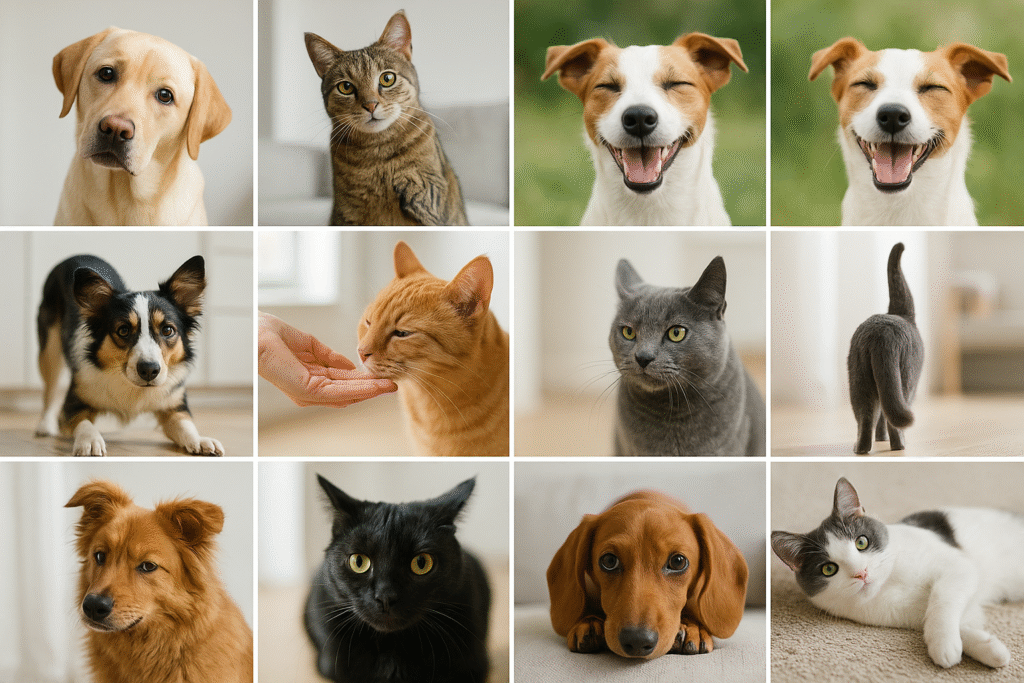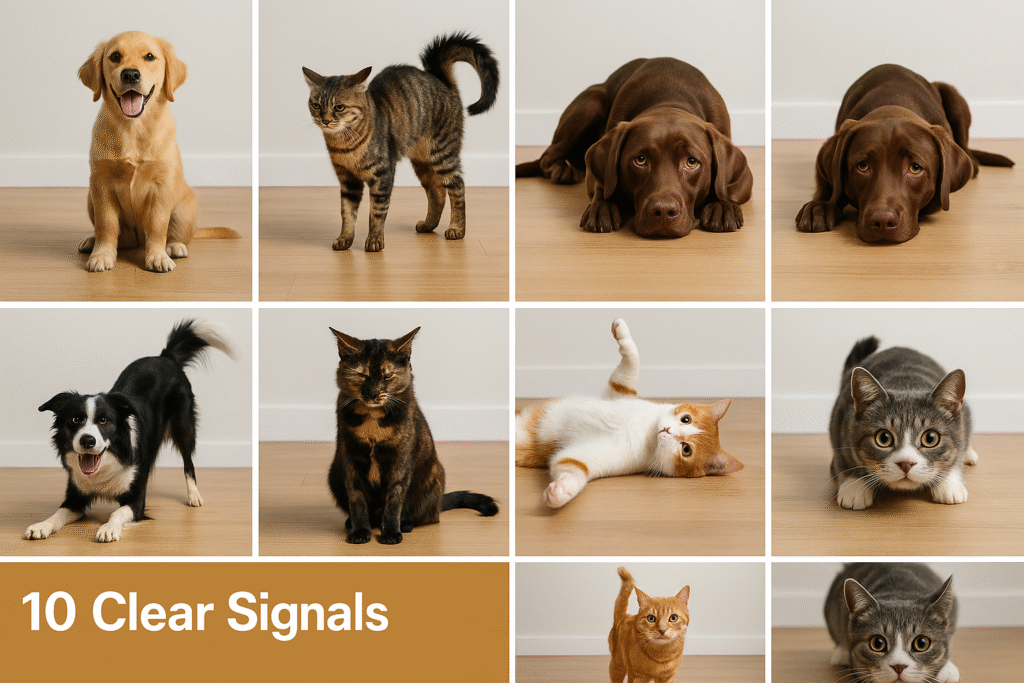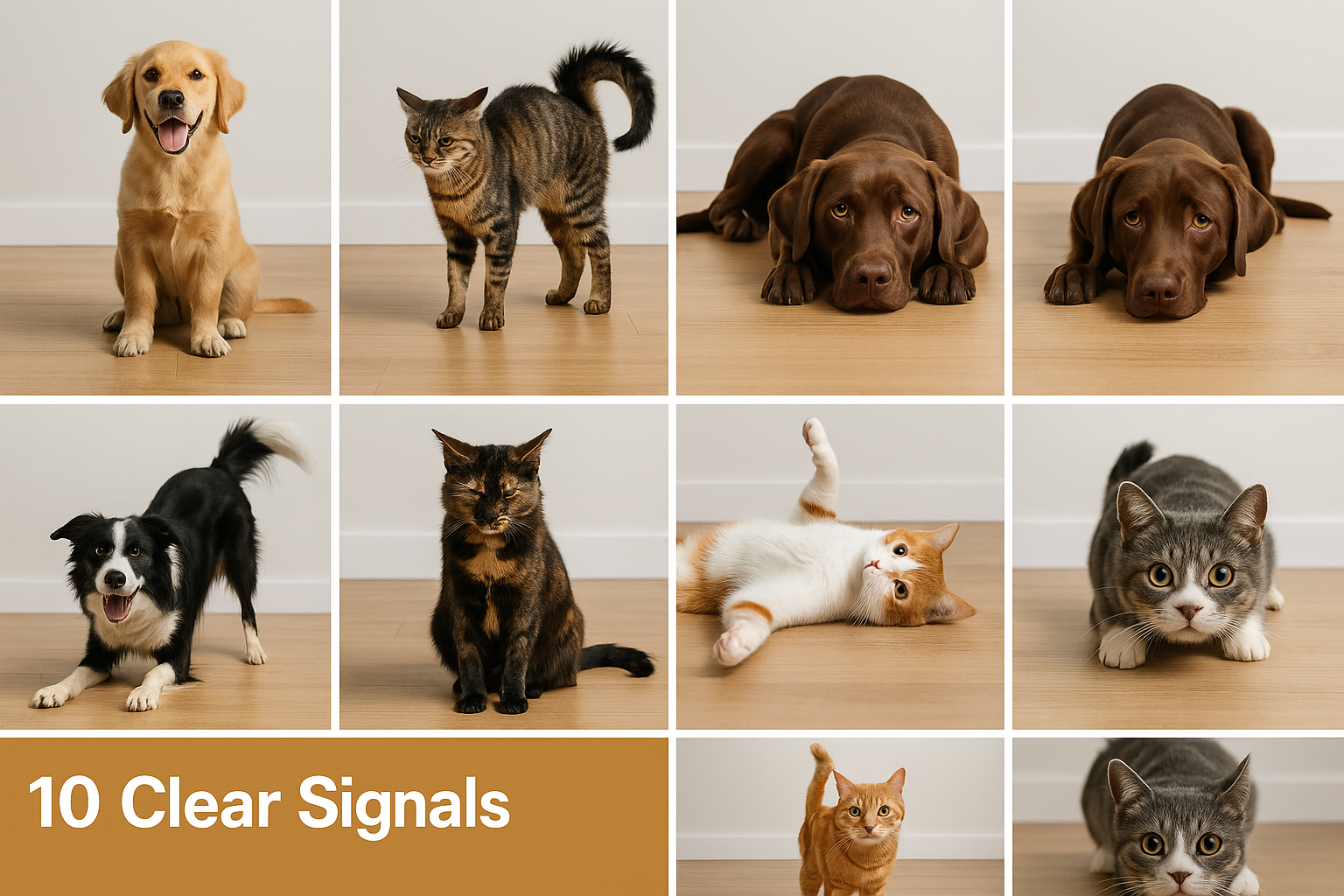Want to understand what your furry roommate is really saying when they stare at you, tuck their tail, or purr in the middle of the night? This friendly, step-by-step guide teaches new and seasoned pet parents how to Decode Your Pet’s Body Language so you can respond with calm, confidence, and care. We’ll cover dogs and cats (the two most common companions), share practical DIY tips, give real examples, and include official resources so you can learn more.
Keywords you came for: Pets Body Language and Decode Your Pet’s Body Language — sprinkled naturally, explained clearly.

Why learning pets’ body language matters (fast)
Pets talk mostly with their bodies. Reading the cues right helps you:
- Prevent bites or scratches by spotting discomfort early.
- Build trust through better responses to fear, stress, or joy.
- Spot illness sooner — animals hide pain well, so behaviour changes are vital clues. (Tufts University, kb.rspca.org.au)
How to read body language — the golden rules
- Look at the whole animal, not just one signal. A wagging tail + stiff body + raised hackles ≠ friendly. (American Kennel Club)
- Context is everything. A cat with a puffed tail during play looks different to one with a puffed tail near a strange dog. (NextGen)
- Slow is safe. If you’re unsure, give space and observe from a distance. The CDC also advises supervising interactions, especially with children. (CDC)

1) Tail Talk — what wagging, flicking and tucking mean
Dogs: A wag isn’t always “happy.” Tail height, speed, and direction matter:
- High and stiff: alert or confident (may be aroused).
- Fast, loose wag with relaxed body + play bow: friendly.
- Low or tucked between legs: fear or submission. (American Kennel Club, Science)
Cats: Tail signals are subtler:
- Tall, tip-curled (question-mark): friendly greeting — often an invitation to approach.
- Slow swish: focused/irritated.
- Puffing up (fluffed tail): frightened or defensive — give space. (PetMD, Alley Cat Allies)
DIY tip: film short 10–20 second clips of your pet during play and calm times. Slow playback helps you spot repeat patterns (e.g., tail flicks before a bite) so you can interrupt and redirect early.
2) Ears & Eyes — small changes, big meaning
Dogs:
- Ears forward + direct stare = focused or interested (could escalate).
- Ears back + whale-eye (showing whites) = anxiety or discomfort.
- Soft blinking + relaxed eyes = calm, trusting. (American Kennel Club)
Cats:
- Slow blink = trust and relaxation (try slow-blinking back to bond).
- Wide, dilated pupils = excitement, fear, or low light — use other cues to decide.
- Flattened ears = fear/anger — avoid approaching. (icatcare.org, RSPCA Queensland)
DIY tip: Teach kids to look at a pet’s eyes & ears before touching. Make a family poster: “EARS FORWARD = ASK OWNER” and “EARS BACK = GIVE SPACE.”
3) Mouths, Whiskers, and Vocal Signals
Dogs:
- Short, relaxed pant + loose mouth = normal.
- Tense lips, closed mouth, or snarling = warning — back away.
- Excessive yawning in a calm situation can signal stress. (American Kennel Club)
Cats:
- Purring usually signals contentment—but can also be self-soothing when sick or frightened. Check posture and appetite to interpret purrs.
- Hissing/growling = clear defensive warning — never force interaction. (RSPCA Queensland, kb.rspca.org.au)
DIY tip: Keep a “sound log.” Note when certain vocalizations occur (time, triggers, other animals present). Patterns help your vet or behaviorist diagnose stress vs. medical causes.
4) Hackles, Fur, and Coat Signals
Raised hair along the back (hackles) can mean high arousal in dogs — not always aggression, but it’s a red flag to watch body posture and tail. In cats, piloerection (hair standing up) is often paired with arching and hissing — classic fear/defense. (American Kennel Club, NextGen)
5) Posture & Movement — read the whole silhouette
- Relaxed: loose body, tail and mouth in normal positions — all good.
- Cowering/hunched: fear, pain, or submission — be gentle and consult your vet if this is new.
- Stiff, leaning forward: possible challenge or high arousal — avoid getting between animals. (Tufts University, kb.rspca.org.au)
Practical test: if your dog or cat stiffens when a person approaches, step back. Offer a treat tossed to them rather than direct reach to rebuild trust.
6) Play Signals vs. Aggression — how to tell the difference
Play often includes:
- Dogs: play bow (front legs down, rear up), bouncy hops, relaxed vocalizations.
- Cats: pouncing and mock “attacks” with quick recoveries, ears forward.
Aggression tends to include a combination of stiff posture, prolonged direct stare, snarling or firm growls/hisses, and rigid tail. When in doubt, separate calmly and give a cooling-off period. (American Kennel Club, Alley Cat Allies)
DIY tip: Teach a reliable “break” cue (e.g., “enough” + treat). Train both dogs and cats to respond to a calm cue to stop play before it escalates.
7) Signs of Pain or Illness — behaviour that demands immediate attention
Animals often hide pain. Watch for:
- Changes in vocalisation, appetite, elimination, grooming, and energy levels.
- Increased aggression or withdrawal from normal interactions.
- Hunched posture, limping, or sudden reluctance to jump or climb. (kb.rspca.org.au, Tufts University)
If you spot these changes, contact your vet. Early detection often improves outcomes.
8) Reading Multi-Pet Interactions — peacemaking basics
- Look for calming signals (sniffing, turning head away, licking lips) — these reduce tension.
- Interrupt rising tension early: redirect with separate toys or a calm call.
- Supervise introductions between new animals slowly and in neutral territory. (Tufts University, icatcare.org)
DIY tip: Keep a short hallway or baby gate handy for gradual introductions. Let animals meet nose-to-nose safely through the gate then progress to supervised face-to-face with treats.
9) Teaching Kids to “Decode Your Pet’s Body Language”
Kids should learn three simple rules:
- Ask the owner before petting.
- Look for relaxed versus tense signals (loose body = okay; stiff/tucked tail = stop).
- Gently touch only safe zones (dogs: chest/shoulder; cats: under chin/cheeks) and always stop if the pet moves away. The CDC recommends supervising animal interactions with children for safety. (CDC)
Practical family activity: Make a “reading chart” with photos of your pet (relaxed, scared, playful). Ask kids to guess what the animal feels — reward correct answers with treats.
10) When to Call a Professional (behaviourist, trainer or vet)
Seek professional help if:
- Aggression is frequent or escalating.
- Your pet shows sudden, unexplained changes in behavior (could be medical).
- Fear, anxiety or separation problems interfere with everyday life.
Look for accredited behaviourists (e.g., members of IAABC or certified trainers). And always rule out medical issues first with your veterinarian. (AVMA Journals, Tufts University)

Quick Reference: 1-page Cheat Sheet (printable)
- Relaxed: loose body, soft eyes, wag/tail neutral = friendly
- Playful: play bow, bouncy, pouncing = let play continue, but watch intensity
- Stressed: yawning, lip lick, whale-eye = reduce intensity and give space
- Fearful: tucked tail, flattened ears, hiding = don’t force contact; calm retreat
- Pain/sick: decreased appetite, limping, sudden aggression = vet visit
(If you’d like, I can turn this into a printable PDF checklist for your blog readers — say the word!)
Official & Reliable Resources (for further reading)
- CDC — Healthy Pets, Healthy People (safety & supervision tips). (CDC)
https://www.cdc.gov/healthy-pets/ - RSPCA — Cat and dog behaviour guides (UK). (RSPCA, NextGen)
https://www.rspca.org.uk/adviceandwelfare/pets/cats/behaviour - AKC — How to read dog body language (practical examples). (American Kennel Club)
https://www.akc.org/expert-advice/training/how-to-read-dog-body-language/ - International Cat Care — Handling and interactions (cat welfare best practices). (icatcare.org)
https://icatcare.org/articles/handling-and-interactions - GOV.UK — Caring for pets and animal welfare (legal duties and guidance). (GOV.UK)
https://www.gov.uk/caring-for-pets
Final checklist — 7 practical steps to start decoding today
- Observe 3 times daily for 2–3 minutes and note posture + tail + ears.
- Film 10–20 sec clips of moments that worry you to spot patterns.
- Teach family “LOOK BEFORE TOUCH” and a child-friendly cue chart.
- Introduce new animals slowly with barriers and treats.
- Reward calm behaviour (treats, praise) — don’t punish fear.
- Contact a vet immediately for sudden behaviour changes or signs of pain.
- Bookmark the official resources above and read one article per week to build knowledge.
Parting thought
Pets don’t speak our language — they speak in signals. The more you tune in, the deeper your bond, the safer your home, and the earlier you’ll catch things that need help. Start small: watch, record, then respond kindly. Your pet will thank you with years of companionship.
Disclaimer: This article is educational and not a substitute for professional veterinary care. If you suspect your pet is ill or in pain, consult a licensed veterinarian promptly. For severe behaviour or aggression concerns, seek an accredited behaviorists or certified trainer. All images used in this article are royalty‑free or licensed for commercial use and are provided here for illustrative purposes.
